What Percent Of The World Suffers From Lack Of Clean Water
There'southward nothing more than essential to life on Earth than h2o and our ability to overcome water scarcity. From Primal Australia to sub-Saharan Africa and Asia's teeming megacities, h2o is scarce. People are struggling to access the clean water they need for drinking, cooking, bathing, manus-washing, and growing their nutrient.
What is water scarcity?
Water scarcity is divers as a water deficiency or a lack of safe water supplies. As the population of the world grows and the surround becomes further afflicted by climate change, access to fresh drinking h2o dwindles.
Globally, 785 1000000 people lack access to clean drinking water. Every day, over 800 children die from dirty water, due to diarrhoea caused past poor water, sanitation and hygiene and scarce or unreliable h2o and sanitation facilities in many communities around the earth.
The impacts of water scarcity affect families and their communities. Without make clean, hands accessible water, they can become locked in poverty for generations. Children drop out of schoolhouse and parents struggle to make a living.
Women and children are worst affected - children because they are more than vulnerable to diseases of dirty water and women and girls because they often behave the burden of carrying h2o for their families for an estimated 200 million hours each 24-hour interval.
Access to clean h2o changes everything; information technology'southward a stepping rock to evolution. When people gain access to clean water, they are improve able to practise skillful hygiene and sanitation.
Children enjoy proficient health and are more than likely to nourish school. Parents put aside their worries nigh water-related diseases and lack of admission to clean h2o. Instead, they can focus on watering their crops and livestock and diversifying their incomes.
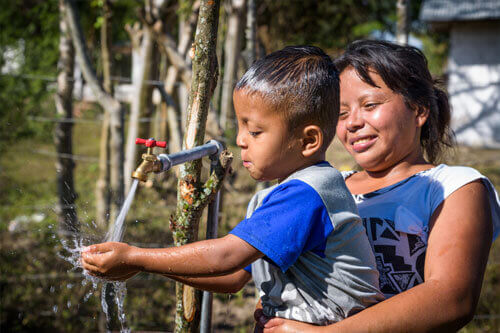
Johanna, 23, holds her son David, five, so he can launder his face and drink clean h2o flowing from one of the taps in the Jamastran Valley of Republic of honduras. The water system was built by the customs with support from World Vision.
Facts of the Global water crunch
1700s to 1800s: Industrialisation leads to increased urbanisation in England, highlighting the need for make clean h2o supplies and sanitation.
1800s: Water shortages kickoff appear in historical records.
1854: Dr John Snow discovers the link betwixt water and the spread of cholera during an outbreak in London.
1900s: Since 1900, more than 11 billion people have died from drought, and drought has affected more than than one billion people.
1993: The U.N. General Assembly designates March 22 as Globe Water Day.
2000: The U.Due north. member states set Millennium Evolution Goals (MDGs) for development progress, including a 2022 target to halve the number of people without sustainable access to rubber drinking water.
2003: Un-Water was founded every bit coordinating platform for issues of sanitation and fresh water access.
2005: Thirty-5 percent of the global population experiences chronic water shortages, upward from nine percent in 1960.
2005 to 2022: United nations member states prioritise water and sanitation development in an International Decade for Action chosen "Water for Life".
2008: The UN-recognised International Year of Sanitation prioritises health and dignity.
2010: The MDG'southward clean water access target is achieved five years ahead of schedule. More than two billion people take gained access to rubber drinking water since 1990. The UN General Assembly recognises the right of each person to have adequate supplies of water for personal and domestic use that are physically accessible, equitably distributed, safe and affordable.
2013: The Un designates 19 Nov as Globe Toilet Day to highlight the global issue of billions of people left without access to proper sanitation.
2015: About ii.6 billion people have gained admission to clean water in the final 25 years, and about 1.4 billion gained basic admission to sanitation since 2000. The Un fellow member states sign on to the Sustainable Evolution Goals (SDGs) – successors to the MDGs that promise clean water and sanitation for all by 2030.
2018: Worldwide, 2.1 billion people still live without safe drinking water in their homes and more than one billion people still take no selection but to defecate outside.
Our piece of work towards a solution
World Vision is the leading humanitarian provider of make clean drinking water in the developing world. We focus on bringing water to the extremely poor — including those with disabilities — in rural areas with the greatest disease brunt.
In 2022, more than than 4 one thousand thousand people were reached with clean h2o through Earth Vision's projects. That'southward one new person every ten seconds.
More than than 700 World Vision h2o, sanitation, and hygiene (Wash) professionals and thousands of development professionals alive and work in communities worldwide to co-create solutions that concluding.
Earth Vision fights against the water crunch to keep the water flowing. We invest an average of fifteen years in a community, cultivating local buying and training locals to manage and maintain water points.
An contained study past The Water Plant at the Academy of Northward Carolina, one of the premier academic groups in water research, examined 1,470 water sources in 520 communities located in the Greater Afram Plains region of Republic of ghana. Their report, published in 2022, showed that nearly 80 percent of wells drilled by World Vision continued to function at loftier levels fifty-fifty later 20 years, thanks largely to our community engagement model.
Earth Vision believes we can solve the world h2o crisis inside our lifetimes. Our efforts include:
- drilling, developing, and repairing wells and other vital water points;
- didactics local customs members how to go along water flowing;
- overseeing the building of latrines and manus-washing facilities; and
- promoting healthy hygiene practices through education and behaviour change programming.
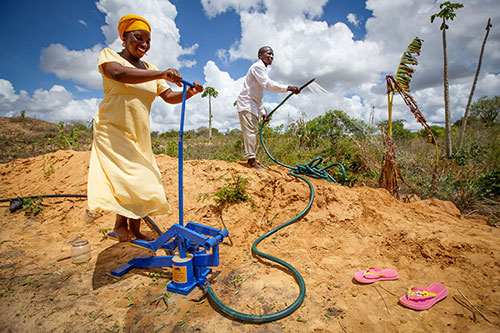
In Kenya, Margaret, 45, operates a pedal pump to gargle her field with aid from Isaac. Their customs benefits from a borehole, pipeline, and water kiosk system World Vision installed in 2022. Before the water arrangement, she made a meager living by farming a half-acre field; at present she grows lush crops on 6 acres.
Timeline of World Vision'south water projects
1960s: Earth Vision begins pocket-size h2o projects.
1980s: Severe droughts in Africa focus the world's attending on the urgent need for water.
- 1985: World Vision begins water drilling projects in Ghana.
1990s: World Vision increases commitment to clean water.
- 1990: Conrad North. Hilton Foundation partners in the Republic of ghana water effort.
2000s: Earth Vision scales up water piece of work to combat increasing h2o scarcity issues.
- 2003: West Africa H2o Initiative extends drilling into Mali and Niger.
- 2005: West Africa's ii,000th well is drilled in Ghana.
- 2006: Large-scale water piece of work begins in Ethiopia.
- 2011: World Vision begins intentional scale-upwards of water and sanitation activities in 10 countries in Africa. Numbers of clean water beneficiaries increase 20-fold when comparing 2022 to 2022.
- 2012: Drilling begins in Honduras.
- 2013: Drilling begins in Republic of india. Earth Vision and Procter & Hazard (P&G) partnership reaches milestone of one billion litres of purified water delivered to developing nations.
- 2014: University of North Carolina study reveals nearly 80 per centum of Earth Vision wells in Ghana office at loftier levels, even afterward 20 years. 1,000th productive well is drilled in Mali. In December, the US Congress passes Water for the Globe Act, prioritising the provision of clean water and sanitation for the globe's virtually vulnerable people. World Vision starts reaching one person every 30 seconds with clean water.
- 2016: Earth Vision expands Wash work into more countries in Latin America and the Caribbean, along with the Centre East. We attain 4.6 million new people with clean water.
- 2017: Earth Vision at present reaches one new person every 10 seconds with clean water.
- 2018 to 2030: World Vision sets aggressive goals for global water work. One objective is to serve 20 meg new people with make clean water and sanitation by 2022 and l million people by 2030.
Learn more about Globe Vision's water piece of work.
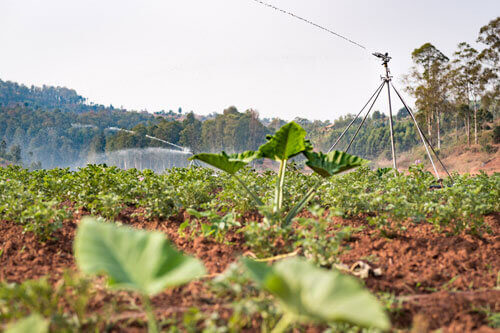
A sprinkler irrigation system in Rwanda rotates among farmers' plots so all the farmers' crops are watered. Earth Vision provided the h2o organization and established a water users' clan for farmers.
FAQs: What yous need to know near the global h2o crisis
Explore frequently asked questions near h2o, sanitation and hygiene and learn how you tin help children and families who lack clean water.
- Fast facts: Global water crunch
- How can I help end the global h2o crisis?
- What are the benefits of water, sanitation and hygiene for children and families?
- Why practise y'all combine make clean water with sanitation and hygiene? What is Launder?
- How are women and girls affected by lack of clean water?
- How much does it price to bring clean water to one person?
- What is World Vision's 2030 goal for its h2o programs? Is it achievable?
Fast facts: Global h2o crisis
- 780 million people lack bones drinking water admission, more than one of every 10 people on the planet.
- Women and girls spend an estimated 200 million hours hauling water every day.
- The average adult female in rural Africa walks 6 kilometres every twenty-four hour period to haul 18kgs of water.
- Every mean solar day, more than 800 children under the historic period of 5 dice from diarrhoea attributed to poor h2o and sanitation.
- 2.iii billion people live without access to basic sanitation.
- ane billion people practice open defecation.
- ninety percent of all natural disasters are water-related.
Back to questions
How tin can I help end the global water crisis?
Clean, fresh water is essential to life. You tin can help bring clean water to families in need as a supporter of World Vision. Over the concluding 5 years, we reached more than 14 million people with clean water. Our goals for the future are even more than ambitious, simply doable, with your help.
Donating to Globe Vision's water projects help bring us closer to catastrophe the global water crisis. Here's how.
Getting access upwards and running
Your donations help to improve access to sanitation through the use of wells, boreholes, h2o tanks, toilets, taps and sewage infrastructure. To enable long-term success, we provide vital pedagogy about sanitation and hygiene in social club to empower communities to advocate for, build and maintain their own facilities and infrastructure.
Mobilising communities for lasting change
-
The spread of disease is preventable. We create lasting impact by empowering households to take the initiative to build, use and maintain toilets. Nosotros help to provide awareness and understanding so that communities can propel themselves into activeness.Natural leaders can emerge every bit they collectively decide how to create a more hygienic and safe environment. When communities pattern and bulldoze their own locally-advisable initiatives, at that place is greater ownership and sustainability.
Creating a clean kickoff for children
- The starting time 1,000 days of life for a child are crucial to their overall wellness. During early childhood, nosotros integrate our h2o, sanitation and hygiene work with diet, early on childhood development and maternal, newborn and child wellness. This is far more effective than addressing whatsoever of these areas in isolation.
Dorsum to questions
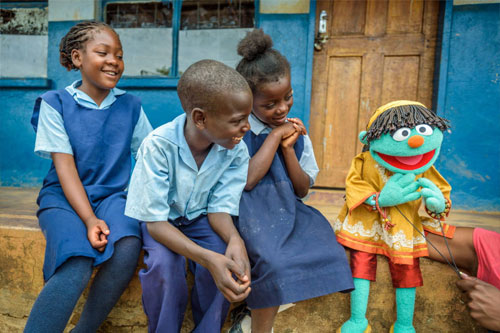
Children in Zambia run into Raya, a Sesame Street Muppet, who introduces kids to things they demand to know almost clean water. Sesame Street and World Vision are working together to assistance terminate the global water, sanitation, and hygiene crisis.
What are the benefits of water, sanitation and hygiene for children and families?
Clean water, combined with basic sanitation and hygiene education, is one of the nearly effective ways to meliorate lives and fight farthermost poverty. Here are a few benefits:
- Families become healthier: Water, sanitation and hygiene programs work together to powerfully foreclose the spread of well-nigh illnesses, and are 1 of the about effective means to reduce child deaths.
- Children are better nourished: Safe water, sanitation and hygiene aid kids grow taller, smarter, and stronger. They get more nutrition from the food they eat because they are not ill. Families are able to employ water to gargle gardens for more nutritious food year-circular.
- Children tin can attend and excel in school: When children don't have to walk long distances to get water, they take more fourth dimension to attend school and more free energy to learn. This is especially important for girls, who most often collect water for the family.
- Family income improves: Families spend less money on healthcare and are better able to pay for things like schoolhouse supplies and fees. Water can also be used for income-generating activities like making soap, bricks and shea butter, as well as watering livestock and gardens.
Back to questions
Why exercise you lot combine make clean water with sanitation and hygiene? What is WASH?
Providing hygiene didactics and sanitation facilities, such as toilets and manus-washing stations, multiplies the health benefits of clean water by helping to reduce the spread of disease and disease.
In fact, mitt-washing alone has been shown to upshot in children growing taller, stronger and smarter. And so intertwined are the issues of h2o, sanitation and hygiene that they accept been combined into 1 sector known in the global aid community as Wash.
Back to questions
How are women and girls affected by lack of make clean water?
Women and girls conduct the greatest burden in the developing globe because they are often responsible for hauling water to their homes. They spend an estimated 200 meg hours collecting water every twenty-four hours. The average African woman walks six kilometres to booty 18kgs of water each twenty-four hours. This daily grind saps her energy for other activities and robs her of the opportunity to spend this fourth dimension with her family, or pursue school and income activities to ameliorate their lives.
Girls who attend schoolhouse until adolescence are more likely to drop out when they starting time menstruating unless their school has clean water, toilets, sanitary supplies and hygiene training. Helping young women to manage menstrual wellness is non just well-nigh providing appropriate facilities, simply also includes addressing social norms.
At childbirth, lack of sanitation, make clean h2o and proper hygiene contribute to high rates of disease and death amongst mothers and newborns in the developing world. Earth Vision is accelerating its push to bring make clean h2o, toilets and hand-washing facilities to more wellness clinics to assure safer deliveries.
Back to questions
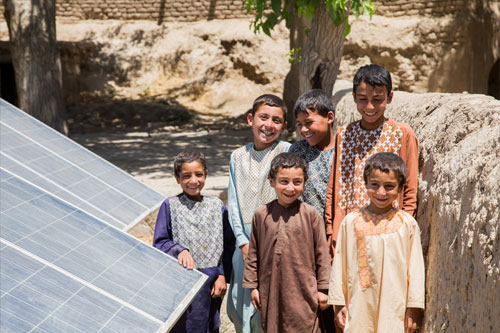
Children stand by a solar panel that powers a drinking h2o decontamination system in the Langar district in Afghanistan. Earlier World Vision installed the system, they had to walk xxx minutes to reach a dangerously contaminated water source.
How much does it price to bring clean water to one person?
Our average cost for World Vision to bring make clean water to i person in Africa is $50. Only this price actually includes much more than than just clean water. It too includes the costs involved to ensure that a well or water point is maintained and then it will concluding for generations.
Moreover, by leveraging other resources like kid sponsorship and local funds, each person who benefits from clean water is too trained and equipped to do safe sanitation and hygiene.
Back to questions
What is World Vision'southward 2030 goal for its water program to help overcome the global water crunch? Is it achievable?
Globe Vision's goal is that by 2030 all communities located inside our development areas worldwide will have admission to rubber h2o (defined as a xxx-minute or less circular-trip walk to the h2o source), adequate sanitation, paw-washing facilities and menstrual hygiene facilities, besides as hygiene promotion and behaviour change.
The global Launder program will specifically promote the inclusion of the most vulnerable men, women and children. It will ensure that people with disabilities, those afflicted past HIV and AIDS, and other vulnerable groups in each area are actively included and benefit from hygiene messaging and increased access to sustainable safe water and improved sanitation.
Based on our achievements over the last five years (nosotros reached more than xiv million people with clean water), we believe that our strategic partnerships with local governments, communities and other humanitarian organisations will help us collectively achieve this goal.
Source: https://www.worldvision.com.au/global-water-crisis-facts
Posted by: parkersookinium.blogspot.com


0 Response to "What Percent Of The World Suffers From Lack Of Clean Water"
Post a Comment